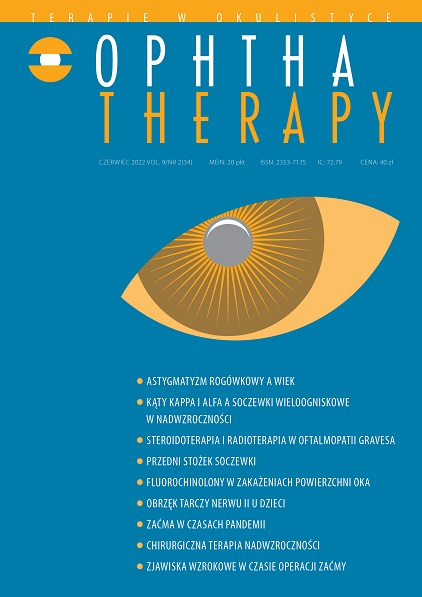Change in corneal astigmatism with age Review article
Main Article Content
Abstract
The work is theoretical in nature and was created to test the relationship between age and changes in astigmatism. The analysis was carried out on the basis of the available studies described in the literature on the subject. The collected statistical data and medical information allow for the conclusion that astigmatism may change with age. The implemented project presents results that have both cognitive and application value. The identified bindings can be used in the medical practice of patients with astigmatism.
Downloads
Article Details

This work is licensed under a Creative Commons Attribution-NonCommercial-NoDerivatives 4.0 International License.
Copyright: © Medical Education sp. z o.o. License allowing third parties to copy and redistribute the material in any medium or format and to remix, transform, and build upon the material, provided the original work is properly cited and states its license.
Address reprint requests to: Medical Education, Marcin Kuźma (marcin.kuzma@mededu.pl)
References
2. Fan DS, Rao SK, Cheung EY et al. Astigmatism in Chinese preschool children: prevalence, change, and effect on refractive development. Br J Ophthalmol. 2004; 88(7): 938-41.
3. Gwiazda J, Scheiman M, Mohindra I et al. Astigmatism in children: changes in axis and amount from birth to six years. Invest Ophthalmol Vis Sci. 1984; 25(1): 88-92.
4. Harvey EM, Miller JM, Schwiegerling J et al. Developmental changes in anterior corneal astigmatism in Tohono O’odham Native American infants and children. Ophthalmic Epidemiol. 2013; 20(2): 102-8.
5. Harvey EM, Miller JM, Twelker JD et al. Longitudinal change and stability of refractive, keratometric, and internal astigmatism in childhood. Invest Ophthalmol Vis Sci. 2014; 56(1): 190-8.
6. O’Donoghue L, Breslin KM, Saunders KJ. The changing profle of astigmatism in childhood: The NICER Study. Invest Ophthalmol Vis Sci. 2015; 56(5): 2917-25.
7. Read SA, Collins MJ, Carney LG. A review of astigmatism and its possible genesis. Clin Exp Optom. 2007; 90(1): 5-19.
8. Naeser K, Savini G, Bregnhøj JF. Age-related changes in with-the-rule and oblique corneal astigmatism. Acta Ophthalmol. 2018; 96(6): 600-6.
9. Sanflippo PG, Yazar S, Kearns L et al. Distribution of astigmatism as a function of age in an Australian population. Acta Ophthalmol. 2015; 93(5): e377-85.
10. Namba H, Sugano A, Nishi K et al. Age-related variations in corneal geometry and their association with astigmatism: The Yamagata Study (Funagata). Medicine. 2018; 97(43): e12894.
11. Read SA, Collins MJ, Carney LG. The infuence of eyelid morphology on normal corneal shape. Invest Ophthalmol Vis Sci. 2007; 48(1): 112-9.
12. Pang YL, Yuan L, Cao XG et al. [Characteristics and analysis of corneal astigmatism in age-related cataract patients over 50 years old]. Zhonghua Yan Ke Za Zhi. 2020; 56(5): 349-55.
13. Hayashi K, Sato T, Sasaki H et al. Sex-related diferences in corneal astigmatism and shape with age. J Cataract Refract Surg. 2018; 44(9): 1130-9.

